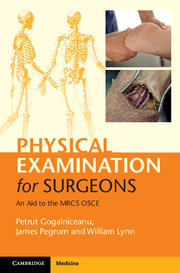Book contents
- Frontmatter
- Dedication
- Contents
- List of contributors
- Introduction
- Acknowledgments
- List of abbreviations
- Section 1 Principles of surgery
- Section 2 General surgery
- Section 3 Breast surgery
- Section 4 Pelvis and perineum
- Section 5 Orthopaedic surgery
- Section 6 Vascular surgery
- Section 7 Heart and thorax
- Section 8 Head and neck surgery
- Section 9 Neurosurgery
- Section 10 Plastic surgery
- Section 11 Surgical radiology
- Section 12 Airway, trauma and critical care
- 63 Examination of the trauma patient
- 64 Examination of the critically ill surgical patient
- 65 Assessment of the airway for intubation
- 66 Assessment of the compromised airway
- 67 Examination of a tracheostomy
- Index
66 - Assessment of the compromised airway
from Section 12 - Airway, trauma and critical care
Published online by Cambridge University Press: 05 July 2015
- Frontmatter
- Dedication
- Contents
- List of contributors
- Introduction
- Acknowledgments
- List of abbreviations
- Section 1 Principles of surgery
- Section 2 General surgery
- Section 3 Breast surgery
- Section 4 Pelvis and perineum
- Section 5 Orthopaedic surgery
- Section 6 Vascular surgery
- Section 7 Heart and thorax
- Section 8 Head and neck surgery
- Section 9 Neurosurgery
- Section 10 Plastic surgery
- Section 11 Surgical radiology
- Section 12 Airway, trauma and critical care
- 63 Examination of the trauma patient
- 64 Examination of the critically ill surgical patient
- 65 Assessment of the airway for intubation
- 66 Assessment of the compromised airway
- 67 Examination of a tracheostomy
- Index
Summary
Checklist
WIPER
• C-spine immobilisation if indicated
Physiological parameters
Look
• Level of consciousness
• Cyanosis
• Abnormal respiratory movements
• Burns/injuries involving head and neck
• Foreign bodies/blood in the oral cavity
Listen
• Stridor
• Voice change
• Gurgling
Feel
• Air movement through nose/mouth
• Chest movement
• Airway reflexes
Examination notes
How do you prepare for an examination of the compromised airway?
• In trauma scenarios use ATLS principles with cervical spine control, using either triple immobilisation or in-line manual stabilisation.
• Ensure there is working suction and oxygen at the bedside.
What are the general observations to be made in the examination?
• Check the patency of the airway. Is there any sign of chest movement and air movement? If there is no air movement, you need to state that you will use simple airway manoeuvres to open the airway – i.e. chin lift/head tilt (avoided in the trauma patient) or a jaw thrust.
• Use an airway adjunct such as a Guedel or nasopharyngeal airway. Once you are satisfied that there is both air movement and chest movement, you can then observe the general appearance of the patient.
• Look for cyanosis, decreased level of consciousness and any obvious signs of trauma or foreign body in or around the airway. If a patient insists on sitting forwards and/or is drooling, this can be a sign of impending airway obstruction: the patient should not be laid flat, and there should be minimal manipulation of the airway.
What may be heard during the examination of a patient with a compromised airway?
• Stridor – a high-pitched sound caused by obstruction of the larynx or lower airway. Changes in the tone of voice may be a sign of airway swelling or vocal cord abnormality.
• Stertor – a low-pitched snoring sound caused by obstruction above the larynx.
How do you check the airway reflexes?
The two main reflexes which protect the lungs from being soiled are:
Cough reflex: can be severely impaired in comatosed states.
Gag reflex: can be tested by using a tongue depressor and gently stimulating the oropharynx.
- Type
- Chapter
- Information
- Physical Examination for SurgeonsAn Aid to the MRCS OSCE, pp. 494 - 496Publisher: Cambridge University PressPrint publication year: 2015



